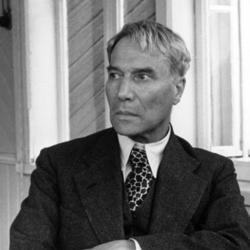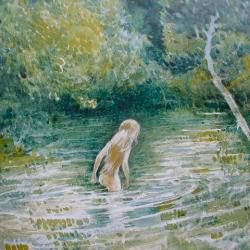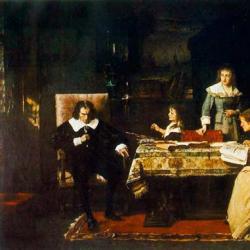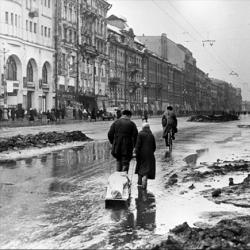Wax dripped from him on the dress with tears. "Winter Night" B. Pasternak - between life and death. Analysis of the poem "Winter Night" by Pasternak
Melo, melo all over the earth
To all limits.
The candle burned on the table
The candle was burning.
Like a swarm of midges in summer
Flying into the flame
Flakes flew from the yard
to the window frame.
Snowstorm sculpted on glass
Circles and arrows.
The candle burned on the table
The candle was burning.
On the illuminated ceiling
The shadows lay
Crossed arms, crossed legs,
Crossing fates.
And two shoes fell
With a knock on the floor.
And wax with tears from the night light
Drip on the dress.
And everything was lost in the snow haze
Gray and white.
The candle burned on the table
The candle was burning.
The candle blew from the corner,
And the heat of temptation
Raised like an angel two wings
Crosswise.
Melo all month in February,
And every now and then
The candle burned on the table
The candle was burning.
Analysis of the poem "Winter Night" by Pasternak
In our time, B. Pasternak is considered one of the most talented Russian poets. Recognition at home came to him after his death. After the publication of the novel "Doctor Zhivago" in the West, Pasternak's work was banned in the USSR. In his most famous work, the writer devoted most of the poetry, which is the fruit of the protagonist's creativity. These philosophical and love lyrics become an organic part of the novel, explaining and connecting the various parts. In this lyric, one of the central poems is "Winter Night". Subsequently, it came out as an independent work. The exact date of writing is unknown, since the writer worked on the entire novel for about ten years.
The central image of the poem is a burning candle, symbolizing a saving light in the midst of the surrounding darkness. She is able to warm and calm the tormented soul. The whole novel as a whole is also permeated in this way. The candle becomes for the lovers the center of the universe, which pulled them to itself and gave shelter in the middle of the "snow haze". Love relationships are outlined with only a few catchy strokes: “crossing of arms”, “crossing of legs”, “heat of temptation”. They are not so important in the general philosophical sense. Much more important is the “crossing of fate”, that is, the union around the life-giving true source of light of two lonely hearts.
In the context of the novel, the image of a candle symbolizes human life, and the surrounding bad weather symbolizes inevitable death. A trembling light is easy to extinguish with a careless movement, it reminds a person that death can come suddenly at the most unexpected moment. On the other hand, the flame of a candle is immeasurably weaker than a hard blizzard, but continues its unequal struggle. The philosophical meaning of this symbolic fight is that a person should never give up and use the time allotted to him to the end.
Pasternak uses a variety of expressive means in the poem. The refrain “the candle burned” is repeated several times, emphasizing the significance of the image. Epithets are used mainly in the description of the February bad weather: “snowy”, “gray-haired and white”. Almost everything that surrounds the main characters is endowed with human features through personifications (“the blizzard molded”, “shadows lay down”). The comparisons used are very expressive: “like midges”, “wax with tears”, “like an angel”.
The poem has become very popular in the post-Soviet space. His words were set to music.
| 1. | Melo, melo all over the earth To all limits. The candle burned on the table The candle was burning. |
| 2. | Like a swarm of midges in summer Flying into the flame Flakes flew from the yard to the window frame. |
| 3. | Snowstorm sculpted on glass Circles and arrows. The candle burned on the table The candle was burning. |
| 4. | On the illuminated ceiling The shadows lay Crossing fates. |
| 5. | And two shoes fell With a knock on the floor. And wax with tears from the night light Drip on the dress. |
| 6. | Gray and white. The candle burned on the table The candle was burning. |
| 7. | The candle blew from the corner, And the heat of temptation Crosswise. |
| 8. | Melo all month in February, And every now and then The candle burned on the table The candle was burning. |
The plot-motive structure of the poem "Winter Night" is quite simple. In the first three stanzas, the core opposition “blizzard-candle” is outlined and consolidated. The plot generated by the confrontation of these contextual antonyms is dominated not by the event (subject-situational), but by the suggestive (associative-symbolic) plan. The 1st and 2nd verse of the 1st stanza is a poetic generalization that turns the real February snowstorm into a symbol of the all-encompassing winter element:
Melo, melo all over the earth
To all extent...
The trope of the 2nd stanza is an associative-metaphorical likening of snow (blizzard "flakes") to summer "midges", somewhat unexpected in this context:
Like a swarm of midges in summer
Flying into the flame
Flakes flew from the yard
to the window frame.
But the "summer" comparison is unexpected only at first glance. In terms of content, this is a “top-down” metaphor. The seemingly absolute and eternal power of the blizzard (=cold/death/evil) is actually not absolute and not at all eternal: in the end it will be destroyed by the fire (=warmth/life/good) that opposes it. Those signs that are visible in frosty patterns (“The blizzard molded on the glass / Mugs and arrows ...” - stanza 3) apparently go back to the archetypal symbolism of sunlight and, therefore, can be considered as an omen of the impending defeat of the blizzard, t i.e. as a kind of iconic paraphrase of the Old Testament “MENE, MENE, TEKEL, UPARSIN” - prophetic words that “counted” the kingdom of Belshazzar and set the limit for his reign (Dan., 5: 5-28).
Starting from the next, 4th stanza (and until the end of the poem), the attention of the “lyrical author” will alternately focus on what is happening in the room (through a series of subject associations), and then again rush into the boundless blizzard space:
On the illuminated ceiling
The shadows lay
Crossed arms, crossed legs,
Crossing fates.
And two shoes fell
With a knock on the floor.
And wax with tears from the night light
Drip on the dress.
And everything was lost in the snowy haze,
Gray and white.
The candle burned on the table
The candle was burning.
The fire (flame) of a candle gives rise to "crossings" of shadows/fate. Without a doubt, this image-symbol should be considered pivotal. In the 7th stanza, it is variably transformed into the “heat of temptation”, in turn, likened to an angel, whose figure (with raised wings) resembles the outline of a cross:
The candle blew from the corner,
And the heat of temptation
Raised like an angel two wings
Crosswise.
Melo all month in February,
And every now and then
The candle burned on the table
The candle burned (IV, 533-534).
The cross (the root of the words "crossing" and "cruciform") does not appear here by chance - it closes the plot-developing associative-metaphorical chain:
The “crossing of destinies” of the hero and heroine is their cross, that is, fate in its lofty, tragic interpretation. A. Lileeva rightly notes in this regard: “In the Christian tradition, the cross is a symbol of suffering and holiness. This allows us to distinguish in the words “crossing”, “crosswise” not only this physical proximity of a man and a woman, but also this hidden holiness. Love, passion in Pasternak's poem is not only the crossing of bodies and destinies, but also the suffering that brings redemption and salvation.
Lileeva A. G. Poetry and prose in the novel by B. L. Pasternak "Doctor Zhivago" ... S. 33.
I. Smirnov, not without reason, believes that Klintsov-Pogorevshiy is not only a "caricature of an anarchist", but also an "autocaricature": depicting him, "Pasternak also calculated with his anarcho-futuristic past." “In this illumination, the deaf-muteness of the Burnt Ones can be associated<…>With lack of absolute hearing at Pasternak”, which caused the collapse of “his composing career”. See: Smirnov I.P. The novel of secrets “Doctor Zhivago”. pp. 146, 147, 148 et seq.
Boris Leonidovich Pasternak is one of the most famous Russian writers of the 20th century, whose prose and poetry are considered to be among the best. His most famous work is Doctor Zhivago. This is a novel that for the first time in the history of Russian literature combined poetry and prose. And the work “Winter Nights” opens the poetic part of the novel.
Pasternak created a hero who is sensitive and writes poetry. But in order not to distract the reader from the events of Yuri Zhivago's life, the writer places all his lyrical creations at the end of the novel.
History of creation
So, the poem Winter Night ”(Pasternak), the history of which will be described below, was written as part of a larger work. It is this work that opens the collection of poems by Yuri Zhivago. Later, the verse was published more than once separately from the novel and was even set to music. But back to history.
It is no longer possible to establish the exact date of writing the poem, since Pasternak worked on the novel itself for 10 years (1945 - 1955). However, critics are inclined to believe that the poet created his lyrical masterpiece shortly before the end of the novel. This assumption is connected with the fact that in those years Pasternak had already suffered his first heart attack. “Winter Night” is a verse about the struggle between life and death, therefore, this topic should have been close to the writer. And at what other moment, if not on the eve of the last moments of being, can such thoughts come into a person’s head?
Be that as it may, most literary critics believe that the poem was written precisely in 1954-55.
As for the work itself, the novel "Doctor Zhivago" was recognized abroad, Pasternak was awarded the "Nobel Prize" for it. For this, both the work and the writer himself were subjected to serious persecution in their homeland. He was no longer published and expelled from the Writers' Union. Pasternak wrote letters more than once, wanting to convince the government of his loyalty, but this did not help. The opponents of the writer turned to the content of the novel itself, calling it anti-Soviet. And the poem "Winter Night" was subjected to special persecution, as it was recognized as vulgar, decadent and decadent.
Subject

As noted above, the main theme of the poem "Winter Nights" (Pasternak) was the theme of the struggle between life and death. The work itself is very metaphorical, in each of its lines and images a special meaning is hidden.
So, considering the entire text in the context of the struggle, we can conclude that the wind, snowstorm and cold are symbols of death, and the barely glimmering flame of a candle is life. And this fragile light leaves the sick Yuri Zhivago just as it leaves Pasternak himself.
However, along with the gloomy theme of life and death, there is also the theme of love, which is associated with continuing in nature. So, human passion is accompanied by a blizzard, weaving "mugs and arrows" on the windows. However, does nature and the “heat of temptation” have a beneficial effect on the main character?
Idea

The idea of the poem "Winter Nights" (Pasternak) is consonant with the theme. It is embodied in the struggle of a person not only with death, but also with everyday hardships, human temptations. So, the lyrical hero resists both the snowstorm raging outside the window and the temptation that burns his soul. Confusion reigns in the soul of the character, he cannot understand where is good and where is evil. The following semantic series helps to express this in the poem: angel, temptation, “crosswise”.
However, only spiritual strength (which the candle symbolizes) and love can withstand external threats (blizzards). Darkness recedes before the sublime feeling, the house becomes cozy, warming.
The symbol of a candle is noteworthy. She, as noted above, is consonant with the hero himself. She continues to burn (live), despite the pressure of the outside world. The image of a fragile, but continuing to warm candle runs through the entire poem.
Composition of the poem "Winter Night" (Pasternak)
An analysis of the composition of the poem allows us to conclude that the work is based on the antithesis (opposition) of two elements: ice and flame. The blizzard that has engulfed the whole world, swallowed up everything around, breaks against the glass, it cannot penetrate into the room warmed by a candle.
The poem has a ring composition - the last line repeats the first, albeit not exactly. Therefore, this phrase is not only a key one, but the differences in it carry a huge semantic meaning. So, at the end of the poem there is no repetition of "small-shoal" and there is an indication of the time - February. Thus, the poet sums up the storm that has already passed, which means that the power of life and hope has triumphed.

Poetic size
The poetic size provides a strong emotionality to the poem "Winter Night" (Pasternak). An analysis of the structure suggests that the work was written with cross-rhyming, where male (line 1, 3) and female (line 2, 4) rhymes alternate. And the so-called interruption of the rhythm, that is, the reduction of the 2nd and 4th lines, gives the poem a special dynamism.
Conclusion
Thus, the Universe and man, the moment and eternity, merged together in the poem "Winter Nights". Pasternak created a stunningly penetrating, emotional and philosophical work.
With a knock on the floor
Melo, melo all over the earth
To all limits.
The candle burned on the table
The candle was burning.
Like a swarm of midges in summer
Flying into the flame
Flakes flew from the yard
to the window frame.
Snowstorm sculpted on glass
Circles and arrows.
The candle burned on the table
The candle was burning.
On the illuminated ceiling
The shadows lay
Crossed arms, crossed legs,
Crossing fates.
And two shoes fell
With a knock on the floor.
And wax with tears from the night light
Drip on the dress.
And everything was lost in the snow haze
Gray and white.
The candle burned on the table
The candle was burning.
The candle blew from the corner,
And the heat of temptation
Raised like an angel two wings
Crosswise.
Melo all month in February,
And every now and then
The candle burned on the table
The candle was burning.
B. Pasternak "Winter Night"
Translation of the text of the song and two shoes fell - with a knock on the floor
Blizzards were blowing across the land
In all the pieces.
A candle was burning.
Like a swarm of summer midges
Flies to the flame
The flakes flew from the yard
To the window frame.
The Blizzard sculptured on the glass
circles and arrows.
A candle burned on the table
A candle was burning.
On the illuminated ceiling
lay down the shade,
Crossed arms, crossed legs,
A cross of fate.
And fell down two shoes
With a thud on the floor.
And wax tears with a lamp
The dress was dripping.
And all was lost in snowy mist
gray and white.
A candle burned on the table
A candle was burning.
The candle on the barrel from the corner
And the heat of temptation
Raised as an angel, two wings
Phillips.
Melo entire month in February
And
A candle burned on the table
A candle was burning.
Boris Pasternak






